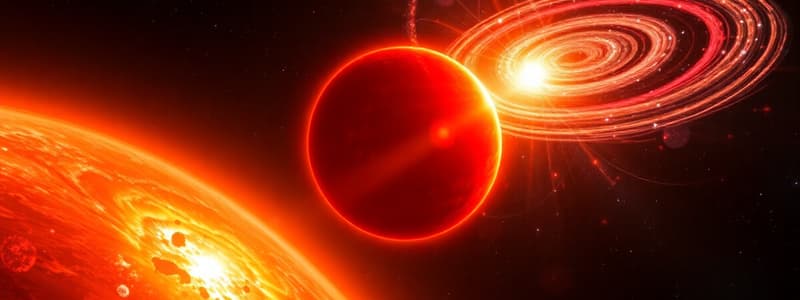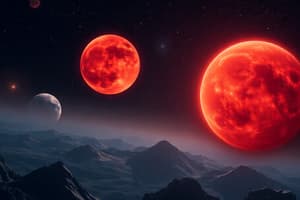Podcast
Questions and Answers
What is the primary factor that determines whether a star will eventually become a white dwarf or a black hole?
What is the primary factor that determines whether a star will eventually become a white dwarf or a black hole?
- The star's surface temperature during its main sequence phase.
- The star's rotational velocity.
- The presence of binary companions.
- The star's initial mass. (correct)
Which of the following sequences accurately describes the evolutionary path of a sun-like star?
Which of the following sequences accurately describes the evolutionary path of a sun-like star?
- Stellar Nebula → Average Star → Red Supergiant → Supernova → Black Hole
- Stellar Nebula → Massive Star → Red Giant → Supernova → Black Hole
- Stellar Nebula → Average Star → Red Giant → Planetary Nebula → White Dwarf (correct)
- Stellar Nebula → Red Supergiant → Supernova → Neutron Star
What triggers the transition of a massive star into a supernova?
What triggers the transition of a massive star into a supernova?
- The accumulation of helium in the core, leading to a helium flash.
- The exhaustion of hydrogen fuel in the core, causing a rapid contraction.
- The sudden fusion of carbon into heavier elements in the core.
- The collapse of the iron core, leading to a catastrophic rebound. (correct)
Which of the following is the correct order of stellar remnants, ranked from least to most massive?
Which of the following is the correct order of stellar remnants, ranked from least to most massive?
What is the primary difference in the final stages of an average star compared to a massive star?
What is the primary difference in the final stages of an average star compared to a massive star?
In the context of stellar evolution, what is the significance of a 'planetary nebula'?
In the context of stellar evolution, what is the significance of a 'planetary nebula'?
What causes a red giant star to increase dramatically in size compared to its main sequence stage?
What causes a red giant star to increase dramatically in size compared to its main sequence stage?
How does the formation of a black hole differ from the formation of a neutron star following a supernova?
How does the formation of a black hole differ from the formation of a neutron star following a supernova?
What is the key difference between a red giant and a red supergiant star?
What is the key difference between a red giant and a red supergiant star?
What event marks the 'birth' of a star?
What event marks the 'birth' of a star?
Flashcards
Stellar Nebula
Stellar Nebula
A cloud of gas and dust in space, where stars are born.
Red Giant
Red Giant
The phase after the main sequence, star expands and cools.
Planetary Nebula
Planetary Nebula
A shell of gas ejected from a low-mass red giant star near the end of its life.
White Dwarf
White Dwarf
Signup and view all the flashcards
Red Supergiant
Red Supergiant
Signup and view all the flashcards
Supernova
Supernova
Signup and view all the flashcards
Neutron Star
Neutron Star
Signup and view all the flashcards
Black Hole
Black Hole
Signup and view all the flashcards
Average Star
Average Star
Signup and view all the flashcards
Massive Star
Massive Star
Signup and view all the flashcards
Study Notes
Life Cycle of a Star
- Stars begin as a stellar nebula.
- An average star develops from a stellar nebula.
- Average stars evolve into a red giant.
- Red giants turn into a planetary nebula.
- Planetary nebulas become white dwarfs.
- A massive star also forms from a stellar nebula.
- Massive stars become a red supergiant.
- Red supergiants turn into a supernova.
- Supernovas can evolve into a neutron star or a black hole.
Studying That Suits You
Use AI to generate personalized quizzes and flashcards to suit your learning preferences.





